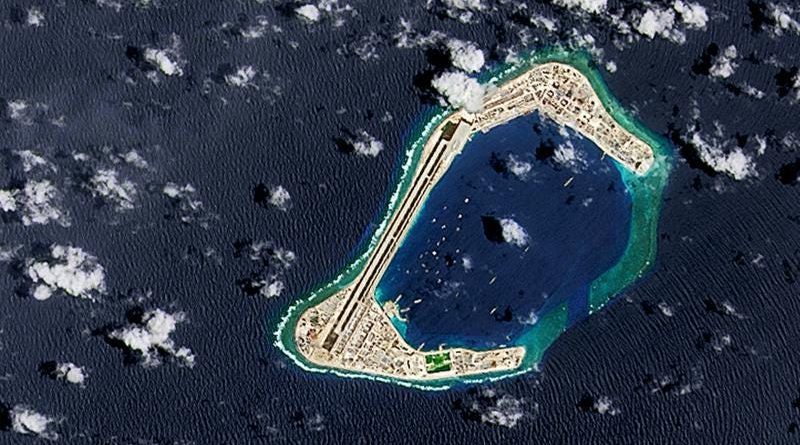China’s Energy Vulnerabilities Drive Xi’s Policies
By Ariel Cohen, Alum of The Fletcher School of Law and Diplomacy at Tufts University
The long-anticipated 20th Party Congress of the Chinese Communist Party, widely seen as Chinese President Xi Jinping’s stage-managed coronation for a third term, began with Xi delivering a two-hour speech focusing on security, further global outreach, and staying the course domestically. None of this surprises China analysts, who predicted these trends far in advance. China’s domestic policy and foreign adventurism are so conditioned by its energy woes, that it does not matter how China obfuscates the specifics by indefinitely postponing the release of basic economic data.
An aggressive military posture, particularly in the South China Sea and Taiwan Straits, is a tempting remedy for Beijing’s energy security problems which avoids policy liberalization. These waters are central to its 2049 ‘regional hegemon’ designs and its economic growth. In 2021, 70% of China’s petroleum and LNG exports, 60% of its total trade, and 20% of all global maritime trade went through these waters via the Straits of Malacca. This geographic choke point is under the firm tactical control of the US Navy and is vulnerable to blockade. It is China’s dream to break or bypass this chokehold. To the alarm of Beijing, these problems only grew worse in 2022. This is the core of the “Malacca Dilemma” that Chinese strategists and policy toil to resolve.
The nine-dash line, China’s largest piece of direct territorial aggrandizement which claims thousands of square miles of territory in the South China Sea, is one of many attempts to resolve this dilemma. This massive claim moves China’s borders and military assets hundreds of miles closer to the Straits of Malacca while giving it an exclusive economic zone containing 11 billion barrels of oil and 190 trillion cubic feet of natural gas.
While China has room for maneuvering and artificial islands in the South, in the Taiwan straits there is no such leeway. Around 50% of the world’s container ships passed through the Taiwan Strait in 2022, making it vital for Chinese exports. This strategic reality combined with the perennial issue of Taiwan’s status makes this a focal point for Chinese action. The fact that the well-defended Taiwan Straits, and the Straits of Malacca, are controlled by increasingly wary foreign powers Beijing.
Redressing these strategic problems with military force remains unlikely in the near to medium term. The military imbalance is lopsided against China while the United States’ Indo-Pacific strategy has succeeded in drawing in a host of cooperative allies. Beijing’s “Wolf Warrior” antics diplomacy has backfired. China’s comparatively weak military-industrial complex, sundry assortment of economic problems, the presence of the US Navy, a recently empowered ASEAN, and the enormous tactical difficulties of amphibious warfare all force China to take a different path.
To bypass geographic choke points and gain alternative sources of energy, Beijing is investing in overland energy connections to Pakistan, Myanmar, Russia, Central Asia, Iran, and Turkey. In the long term, the development of these routes could end China’s vulnerability to naval power and undermine America’s strategic position. Washington is not paying enough attention to China’s continental strategy.
Through the China-Pakistan Economic Corridor (CPEC), China gains direct access to the Indian Ocean and nearby Middle Eastern energy sources. The construction of the new natural gas “peace pipeline” by Chinese company SINOPEC linking Iran and Pakistan will allow Beijing to plug into high-demand energy sources (it already gets 7% of its oil from Iran) and further enter the realm of Middle Eastern politics. Bottlenecks in supply and transit constantly interfere with Beijing’s plans. Challenging topography, transit costs, and anti-Chinese sentiment are all obstacles to this vision, but given the strategic imperative, not unbearable ones.
Other transportation corridors have similar obstacles. In Myanmar, the China-Myanmar Economic Corridor (CMEC) has had to confront problems stemming from a 2021 military coup, thwarted democratization, and ethnic disorder bordering on civil war. Even the remote Northern Sea Route via the Arctic to dodge Malacca is politically endangered by Russia’s invasion of Ukraine. Try as it might, Beijing hasn’t yet hit upon a near-term way around Malacca.
If foreign markets cannot fix China’s energy woes, Xi is hoping domestic investment can. A massive part of Xi’s “Chinese Dream” involves the “energy of the future”, not just for environmental advantages, but because it is a method of decreasing China’s strategic vulnerabilities. The realities of moving such a massive economy and population through the energy transition, especially when hampered by excessive state planning, have caught up to Xi, forcing him to backtrack from earlier plans, even more unrealistic.
Much of China’s economic planning and domestic policy is energy focused and rests on a proven trifecta the USA would be well advised to examine and emulate where possible. First, massive investments in nuclear power, uranium refining, and modular reactors are set to make China the leading nuclear power in Asia. Second, China’s massive investment and dominance in every step of the rare earth mineral supply chain, especially coltan and lithium, is helping China monopolize the energy infrastructure of the future. Thirdly and finally, large investments in hydroelectricity (although this cannot be practically emulated in the US for lack of capacity, environmental, and permitting reasons). China’s much-publicized investment in renewables complements this trifecta but doesn’t feature centrally in any energy plans.
While Xi plans, circumstances (and God) laugh. For all the bluster on display at the 20th party congress, China remains incredibly vulnerable to energy disruptions whether by a foreign actor, or its own domestic failures. These woes drive Chinese policy, foreign and domestic. Energy security is central to Chinese policy and strategy, arguably more than many other state actors. When trying to understand China, don’t look at the tea leaves, look at the power lines.
This piece is republished from Forbes.

